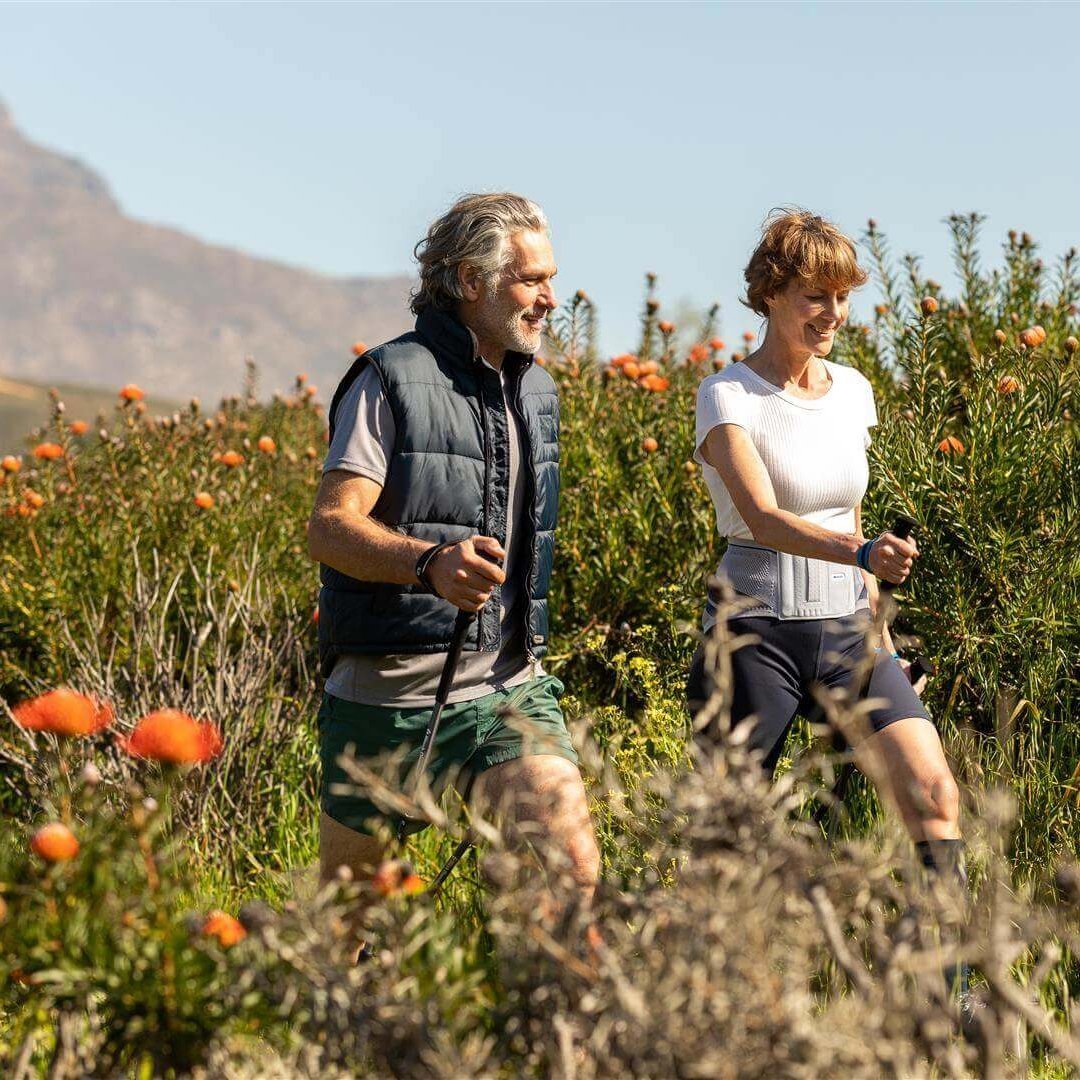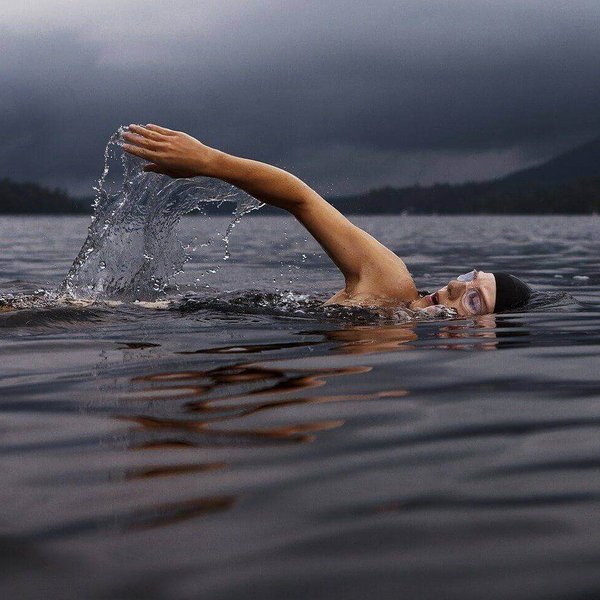We are not (only) designed for the couch. Exercise is good for us and it makes sure that we feel healthy and energetic. The positive effect on our health is increased even more when we’re in the fresh air. But simply going for a walk? We’ve got a better idea: Nordic walking!
Nordic walking refers to a method of fast walking that uses special sticks. This activity is actually suitable for everyone: whether young or old, couch potato or elite athlete. Particularly if you haven’t done any exercise for a while, Nordic walking is a great activity that helps you get back into it. And even if you’re suffering from back pain or knee problems, Nordic walking can be a good option to incorporate more exercise into your leisure time.
Nordic walking: healthy exercise

Nordic walking is an endurance sport that has many benefits for your health. It’s a workout for your whole body: walking activates your leg and buttock muscles, and since you’re also using sticks, your upper body muscles are in demand, too. But don’t worry: you don’t have to go all out and get out of breath. You’re in charge of speed and intensity, meaning you can adapt your training to your fitness level.
Nordic walking – even at a moderate speed – is seen as ideal cardiovascular training. Furthermore, your bones and veins are strengthened, and your metabolism is stimulated. Plus, you burn more calories than when you go for a walk.
Those who regularly make time for Nordic walking can reduce the risk of suffering from widespread conditions and typical age-related problems – for example back pain, cardiovascular diseases, osteoporosis, diabetes, and high blood pressure.
Exercise in the fresh air is not only beneficial for your body, by the way. Your mind will also free up quickly. Spending time in nature is generally good for your mental well-being. And it doesn’t matter if you’re crossing fields and meadows or if you’re doing your rounds in a park. Nordic walking is a perfect way to reduce stress and strike a balance with your hectic everyday life.
Walking or running?
The choice is yours. Walking is much more gentle on your joints than running. The strain on your knees is incredibly high during running compared with Nordic walking. Plus, running generally requires a certain fitness level. Walking means you can start at any time and you won’t get out of breath after a few meters. Nordic walking is therefore preferable to running for beginners and those with preexisting conditions.
Nordic walking in cases of back and knee pain
Those suffering from pain often prefer to rest. But in cases of back pain, moderate exercise is often the better choice. The question will then be: is walking good for the back? Generally, the answer is “yes”. Using the sticks additionally activates the muscles in your upper body, all the way to the tendons in your neck. The asymmetric movement of your arms and legs can loosen tense muscles, thus alleviating pain.

Those suffering from knee pain on the other hand prefer to be more careful. Plus, they often feel a little insecure. This is particularly true if a condition, such as osteoarthritis of the knee, has already been diagnosed. The good news is that Nordic walking is generally seen as an activity that is gentle on your joints. With the correct technique and sufficient attention paid to your body’s signals, you can carefully get into the new movements. And don’t forget: strengthening your leg muscles will help knee stability.
Get advice and support
If, based on your physical constitution, a preexisting condition, regular joint problems, or back pain, you’re not sure whether Nordic walking is the right activity for you, please consult your physician before you start. You can discuss together what in particular you have to bear in mind. To provide your joints and veins with additional support during Nordic walking, medical retailers have appropriate products for your training. We will also give you useful tips so nothing will stand in the way of your joy of movement.
What equipment do you need?

When starting with Nordic walking, you must have appropriate footwear. It’s best if you go to a specialist retailer to try out different running shoes and sneakers. The sole should be sturdy and slightly springy. Special orthopedic foot orthoses provide your feet with additional support if needed. They are particularly advisable if you have a typical foot misalignment, such as valgus, high-arched, arch-decreased, or splay foot. Ask your physician or a medical retailer which foot orthoses are appropriate for you. You should also wear comfortable clothing in which you can move easily. And if it’s made of breathable material – even better!
There’s also a lot to bear in mind when it comes to the sticks. They are available in different materials, such as carbon, graphite, or aluminum. You will be able to notice the difference in weight and stability. This is another case where you should seek advice from a specialist retailer. The most important details are the straps, by the way. You need them to perform the movements correctly. When it comes to stick length, this rule of thumb applies: your height in centimeters times 0.66. When your hands are holding on to the sticks, straps around the wrists, your upper arms and forearms should be at an angle of slightly more than 90 degrees. Please remember: hiking sticks or ski poles are not suitable for Nordic walking! It really is worth making this small investment in proper, high-quality sticks.
Walking properly – the right technique
Nordic walking is more than just walking quickly. The correct use of the sticks, in particular, can be hard to begin with. You should therefore pay attention to your movements and keep to the following rules:
- Take medium paces rather than big steps
- When you put down your heel, keep the angle shallow
- Don’t fully extend your knee during the forward step
- When the left foot touches the ground, put down the right stick – and vice versa
- Avoid supporting yourself on the sticks or putting them down too far ahead of you
- Briefly open your hand when you gently push off with the sticks
- Let your arms swing slightly
- Keep the sticks close to your body when moving them backwards
- Try to walk with a steady rhythm
Take the vitality test!
Do you want to know how your fitness and well-being are doing? Then take the vitality test!

Additional tips for beginners
If you’ve only recently discovered Nordic walking, start at a normal walking pace, then gradually increase speed and intensity over time. You will see: you’ll soon be quicker than you may have initially thought.
Many places offer Nordic walking classes where trained coaches teach you and help you learn and use the technique correctly. Plus, you’ll meet new people.
Ask your partner, a friend, or a colleague to join you. Nordic walking is even more fun with somebody else beside you or in a small group. The commitment will also motivate you.
Everyone enjoys being outside when the sun is shining – but when it’s raining, the couch looks so much more enticing. Don’t let bad weather put you off! A high-quality rain jacket will ensure that you can also do your rounds when it’s wet. You will see: it’s more fun than you think.
After initial enthusiasm, everyday life can quickly get in the way. Don’t get discouraged and stick with it! Plan to go Nordic walking twice a week at least, for example – even if it’s just for half an hour in your local park. And if you’re hesitating, remember how beneficial Nordic walking is and all the good it does for your health. That will get you going again.
Get support

Nordic walking is an activity that strengthens the whole body. That also means that all the joints, from head to toe, are being used. You should therefore speak to your physician before starting. This applies in particular if you are suffering from acute problems or if you have been treated in the past or are currently receiving treatment for a joint-related condition. Your physician will be able to tell you whether you need to bear certain things in mind. Depending on your physical condition or possible (preexisting) illness, it may be useful to support your joints with appropriate medical products. High-quality orthopedic supports are available for the wrists, elbows, back, knees, and feet. They provide your joints with additional stability and can alleviate pain if you’re suffering from acute symptoms. In this way, they will help you stay active and promote your health.
Not only your joints but also your venous system will be grateful for additional support – during exercise, too. Medical compression stockings help your veins in their work and make sure that your legs feel light.
Whether supports, compression garments, or foot orthoses mentioned above – the right quality is important with medical products as is finding the appropriate aid for you. So make sure to seek advice from a medical supply retailer. Also speak to your physician if you’re not sure or if you’ve already got problems. Your physician will be able to give you a prescription for your medical product.
You might also be interested in this





